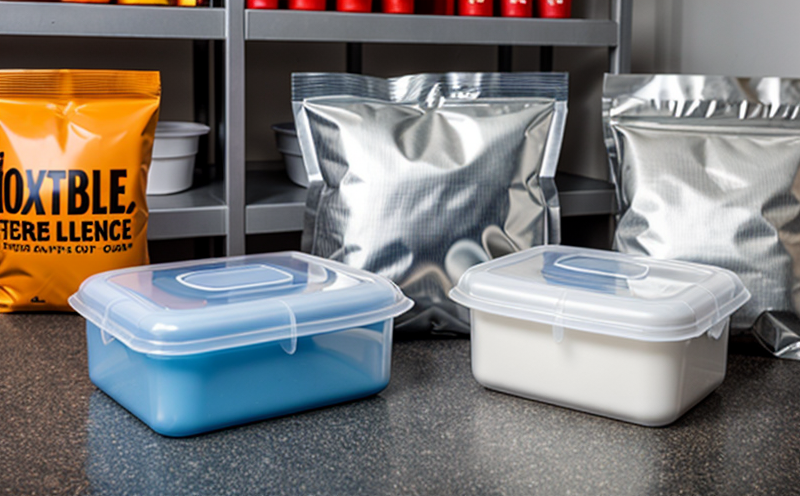ISO 15105-5 Oxygen Permeation Analysis
The ISO 15105-5 standard provides a comprehensive approach to measuring oxygen permeability through flexible packaging materials. This test is essential for ensuring the integrity and quality of packaging that protects food, pharmaceuticals, and other sensitive products from oxidative damage. The method described in this international standard allows laboratories to perform accurate and reproducible tests under controlled conditions.
The process begins with precise specimen preparation. Samples must be cut to a consistent size and shape to ensure uniformity across the test batch. It is crucial that these samples are representative of the packaging material being tested. The specimens are then conditioned in an environment that closely mimics their intended use, ensuring accurate results.
Once prepared, the specimens undergo testing using specialized equipment designed for oxygen permeation analysis. This apparatus typically consists of chambers where the sample and reference material are placed. The difference in oxygen pressure between these two sides is measured over time to determine how much oxygen passes through the packaging material. The rate at which this occurs provides valuable insights into the barrier properties of the packaging.
The testing procedure must adhere strictly to ISO 15105-5 guidelines to ensure consistency and comparability across different laboratories worldwide. This includes temperature control, humidity levels, and time intervals for data collection. These factors can significantly influence the results, so maintaining strict adherence is critical.
After completing the test run, the laboratory generates a detailed report that includes all relevant parameters such as oxygen permeability values, temperatures, humidities, and any deviations from standard conditions. This information is essential for quality managers and compliance officers to make informed decisions about product development and manufacturing processes.
The results of ISO 15105-5 testing are widely recognized by industry stakeholders, regulatory bodies, and international markets. Compliance with this standard not only ensures high-quality packaging but also facilitates smoother supply chain operations and enhances consumer trust in products.
- International recognition of the test method
- Adherence to global standards for packaging integrity
- Precision in measuring oxygen permeability through flexible materials
In summary, ISO 15105-5 is a vital tool for quality assurance and compliance within the flexible packaging sector. By ensuring that packaging meets rigorous testing criteria, this standard helps protect sensitive products from degradation due to oxidation.
Why Choose This Test
Selecting ISO 15105-5 oxygen permeation analysis for your packaging needs offers several advantages over other methods. Firstly, it provides a standardized approach that ensures consistency and comparability across different laboratories globally. This standardization is crucial when dealing with international suppliers or customers who require consistent quality.
Secondly, the test method allows for precise measurement of oxygen permeability through flexible materials. This level of accuracy is essential for ensuring that packaging meets specific performance requirements set by manufacturers and regulators alike. For instance, food manufacturers may specify particular oxygen barrier levels to maintain product freshness and safety.
Thirdly, compliance with ISO 15105-5 demonstrates commitment to quality and reliability in your supply chain management practices. Many organizations today place a premium on sustainability and ethical sourcing; using internationally recognized standards like this one can help build stronger relationships with suppliers and customers alike.
Finally, choosing this test ensures that you stay ahead of industry trends and regulatory changes. As consumer expectations evolve regarding product safety and environmental impact, having robust testing protocols in place will position your company favorably among competitors.
In conclusion, selecting ISO 15105-5 oxygen permeation analysis for your packaging quality assurance process is a strategic decision that supports both short-term operational efficiency and long-term business growth.
Quality and Reliability Assurance
Ensuring the quality and reliability of flexible packaging materials is paramount in today’s competitive market. Oxygen permeation testing plays a crucial role in achieving these objectives by providing quantifiable data on how well your packages protect against oxidative degradation.
By conducting ISO 15105-5 tests, you can identify any weaknesses or deficiencies in the barrier properties of your packaging materials early in the development process. This enables timely adjustments to be made before large-scale production begins, saving time and resources while enhancing overall product performance.
The detailed reports generated from these tests also serve as valuable tools for training personnel involved in packaging design and manufacturing processes. They provide clear guidelines on how to achieve optimal results when working with various types of flexible materials.
Moreover, compliance with this international standard fosters trust among all stakeholders involved - from raw material suppliers to end consumers. When suppliers can demonstrate adherence to recognized standards, they create a more transparent supply chain that benefits everyone concerned.
Lastly, by incorporating ISO 15105-5 oxygen permeation analysis into your quality assurance framework, you signal commitment to excellence and continuous improvement in every aspect of your business operations.
International Acceptance and Recognition
- Australia: Recognized as a key standard for packaging integrity by the Australian New Zealand Food Authority (ANZFA).
- New Zealand: Widely accepted in food safety regulations set forth by the Ministry for Primary Industries.
- United States: Adopted by major industry associations such as Packaging Digest and the American Society of Testing Materials (ASTM).
- Canada: Included in the Canadian Food Inspection Agency’s guidelines for packaging materials used in food contact applications.
- European Union: Part of the EU’s harmonized approach to ensuring safety and quality across member states.
- Japan: Used extensively within Japanese industries as part of their stringent quality control measures.
- Korea: Integral to South Korean food packaging standards established by the Korea Food and Drug Administration (KFDA).
- India: Recommended practice in several Indian state governments’ policies related to food safety and hygiene.
The widespread adoption of ISO 15105-5 across diverse regions underscores its importance as a global benchmark for flexible packaging quality assurance. Whether you are operating within one country or doing business internationally, compliance with this standard helps ensure consistent performance standards everywhere.





